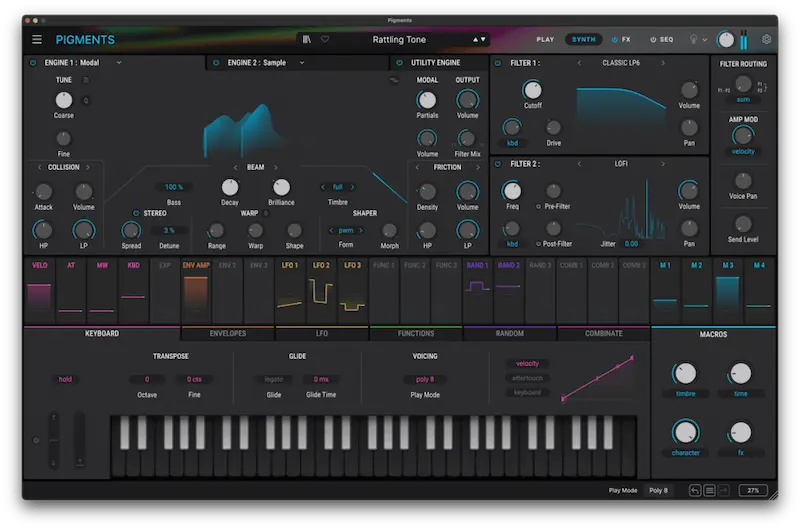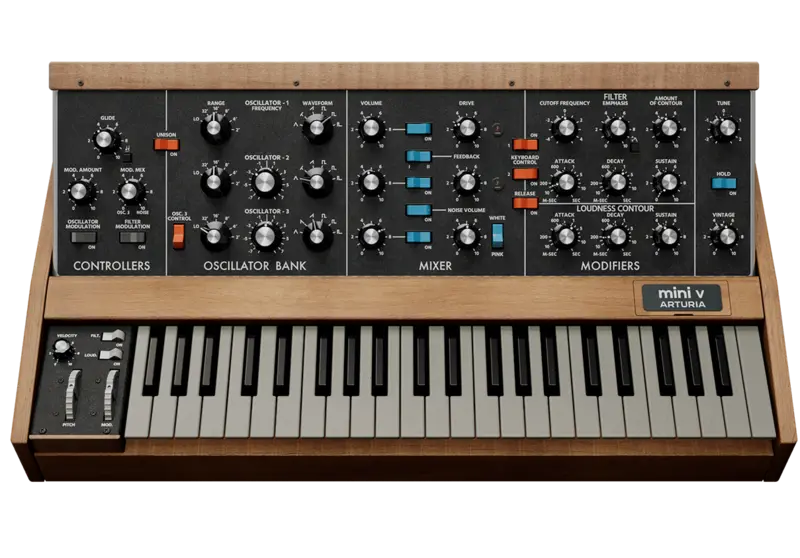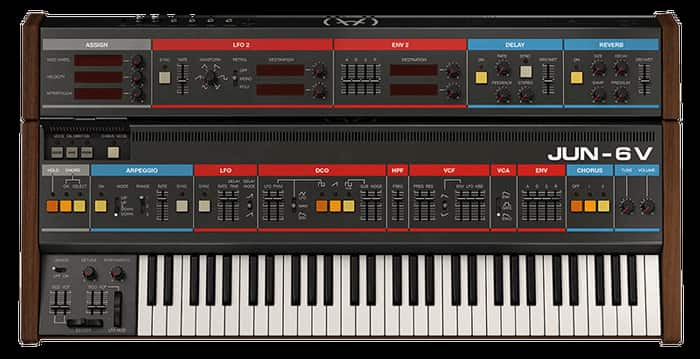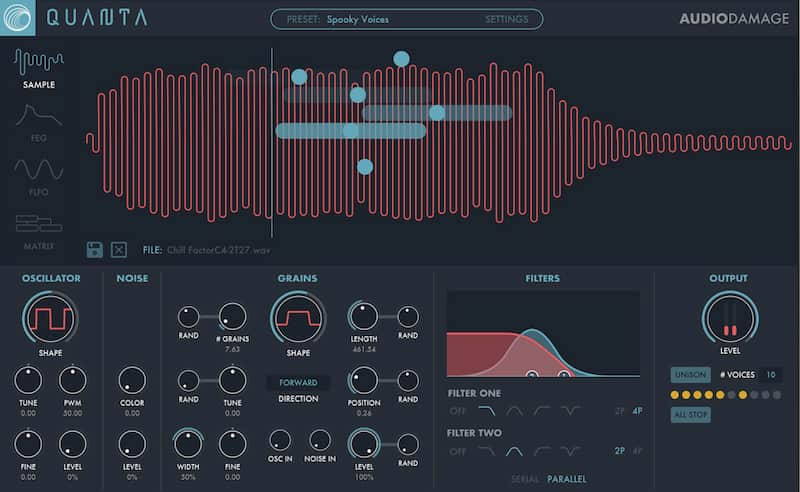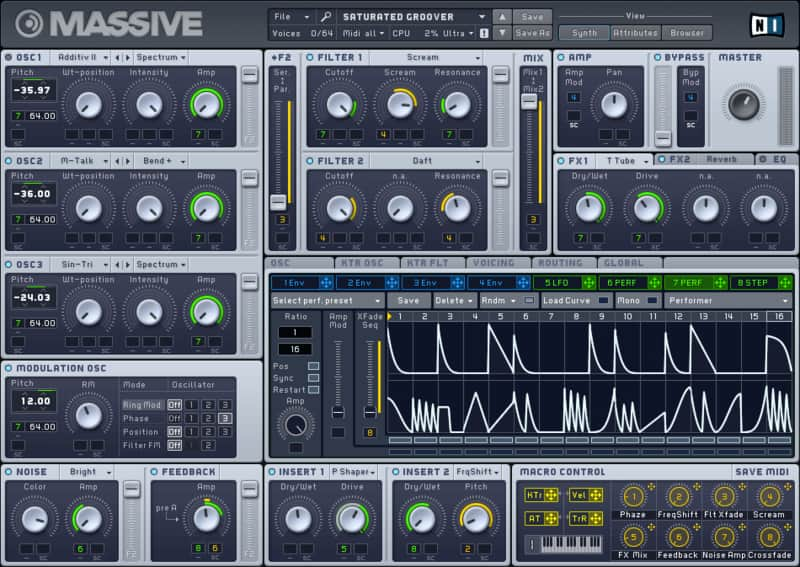Best Synth VSTs

No matter what kind of music you make, there will likely be one point in your music career that you’ll need a synthesizer to create the sound you hear in your head. Unless you have thousands of dollars to shell out on an iconic hardware synth, you’ll probably find yourself browsing the online market for synth VSTs.
Of course, there are thousands of virtual synths on the market today, which can make it pretty overwhelming trying to search for the one that suits your needs.
Luckily, we’ve done our research and played with several of the market’s top synth VSTs to compile our list of favorites.
Note: some of the links below may be affiliate links, meaning that I receive a commission if you purchase through them.
Other Types of Synths
Just a note that this review of the best synth VSTs is focusing on all-around synths. The types that can do searing lead sounds, amazing pads, pounding basses and cutting chords. The type that every producer should have in their arsenal.
But maybe you're looking for something particular.
Before we dive into the best synth plugins, though, we've also put together reviews of other types of synths that might be more what your looking for. If these types of plugins are more up your alley, then go check them out.
| Name | Pros | Cons | Buying Options |
| Pigments |
|
|
Check price! |
| Omnisphere |
|
|
Check price! |
| Mini Moog V |
|
|
Check price! |
| Jun-6 |
|
|
Check price! |
| Wiggle |
|
|
Check price! |
| Quanta |
|
|
Check price! |
| Serum 2 |
|
|
Check price! |
| Massive |
|
|
Check price! |
Best VST Synth 2025 - Arturia Pigments 6
Arturia has some of the best attention to detail out of just about synth VST manufacturers on the market. Their designs are impeccable and they are able to capture the nuances of iconic pieces of analog gear for digital users. Pigments is no exception to the rule that Arturia makes incredible tools
By the way, Arturia says it took them 20 years to develop this synthesizer. In our eyes, that’s some serious dedication and probably one of the reasons this is the best VST synth on the market today. And Arturia has continued to support Pigments, including a free upgrade from Pigments 5 to Pigments 6, adding in new granular processing, a modal engine, a vocoder effect, UI enhancements and more!
At first glance, the interface is gorgeous. Plus, it is super intuitive, unlike many synth VSTs, which can feel complex or overwhelming when you’re getting started. The twin audio engine that Pigments utilize combines wavetable oscillators and virtual analog with a unique sampling engine.
See why pigments has over 1,000 five star reviews!
After you start your patch, you can manipulate the three LFOs, three envelopes, and the three function generators to start cranking out unique tones.
There are three primary windows on Pigments 2, including the effects page, the synth page, and the sequencer page. It’s very easy to navigate, never putting a wrench in your workflow.
If you used the first iteration of Pigments, you’d enjoy the few upgrades that Arturia has to offer, including the brand new sampling engine, which comes with hundreds of brand new samples. If you want to get extra creative, you can even load your own!
With the addition of synth mode, you can take your samples and mash and mangle them to create a wild, out-of-the-world, granular symphony. You can then take it a step further with the sequencer, creating bits of randomization, perfect for pads or arpeggios.
Overall, with its crisp and clear UI, granular synthesis capabilities, and a myriad of unique artist presets to get you started right out the gate, it is one of the best new synthesizers on the market today.
Pros of Pigments
- Lush sound
- Incredible flexibility
- Amazing UI
- Diverse range of sounds
Cons of Pigments
- None
Most Flexible Synth Plugin - Omnisphere
When it comes to flexibility, Omnisphere reigns king. It’s almost as if Spectrasonics is running some sort of dictatorship, because it doesn’t seem like Omnisphere has faced competition as the king of synth VSTs since its creation.
At this point, Omnisphere has reached version 2.6, giving users plenty of great updates. Some of those updates include dividers, new step modifiers, and an arpeggiator with out-of-this-world chord voicings.
If you can’t find just about every sound you need for your production in the 14,000-sound bank, then you probably need to rethink your life.
Read more reviews of Omnisphere here
Of course, the real beauty of Omnisphere is what lies beneath the surface. You can manipulate each patch with up to 20 oscillators, which are either sample-based or DSP. With more than 500 DSP waveforms to choose from, it’s an endless black hole of potential creativity.
But wait, there’s more!
You can also layer four sounds per patch and adjust each patch with up to eight LFOs and 12 envelopes.
If you’re a hardware synth owner, it is worth noting that Omnisphere is compatible with more than 65 hardware synthesizers, allowing you to use a compatible hardware synth as an Omnisphere controller. There isn’t another VST manufacturer with integration quite like this.
Beyond the wild and wacky sounds that you can find underneath Omnisphere’s hood, it’s actually quite a powerful granular synthesizer as well. If you want to get a bit spacey with your textures, it’s easier than ever. I really dig the fact that you can import your own samples and get creative with Omnishpere’s tool kit.
As the cherry on top, you get more than 34 filter algorithms and 58 FX units!
Omnisphere gives you an entire world to explore, and there hasn’t been anything else that can match its versatility.
Pros of Omnisphere
- The most complete synth available
- Incredible sounds
- Massive library of patches
- Flexible
Cons of Omnisphere
- Expensive
- Dated interface
Best Synthesizer for Beginners - Arturia Mini V
As we said before, Arturia is the master when it comes to emulating classic hardware synthesizes. The Minimoog is arguably one of the greatest and most iconic hardware synths ever created. If you want fat, synthesized basslines, there isn’t another synth on the market that can provide that juicy analog sound.
The Arturia V collection is home to more than 30 synth VSTs, though if we had to pick a favorite, it would definitely be the Mini V. With monophonic capabilities and few onboard controls, it offers a wonderful interface to start with if you’re not familiar or comfortable with synthesis.
When it comes to producing heavenly leads or fat analog basslines, it is almost hard to distinguish Arturia’s Mini V from the real thing. No matter what kind of music you make, you’ll have an easy time dialing in the sounds you need with the Mini V.
Plus, Arturia partnered up with Bob Moog to create these VST synths (yes, the creator of this iconic synth), meaning they had all the insider information they needed to replicate it with honesty.
There are SO many synth VST manufacturers that claim their synths can replicate the famous Minimoog. However, after trying out several of the top emulations, I’ve come to the conclusion that Mini V is the most faithful representation. You get this beautiful and warm bottom end that you don’t find in a lot of digital synthesizers. Everything from house-style basslines to funky leads, you can find here.
Though, while you’re not going to find an endless stream of sound design potential with the Mini V, if you want an honest emulation of one of history’s most iconic hardware synths, you need to look no further.
Pros of the Mini V
- Great layout to learn synthesis
- Amazing sound
- Easy to learn, hard to master
Cons of the Mini V
- Not as versatile as the other synths
Best Synth for Ambient Music - Arturia Jun-6 V
In my eyes, the original Roland Juno-60 is one of the best synthesizers for spacey, psychedelic synth tones, and the Arturia Jun-6 V does it absolute justice. You even get the funky toy-like color scheme on the UI that looks like the original. While the slider keys might not be as fun to adjust on-screen, the emulation sounds absolutely incredible and is worth every penny.
Not only do you get several preset patches that match those of the original synthesizer, but you also get tons of new presets that take advantage of unique software upgrades. Overall, with 180 presets to choose from, many of which are perfect for ambient music, there are plenty of places to start.
Open the Advanced Panel, and you’ll find a second LFO, a second ADSR envelope, and a variety of effects like delay and reverb. You’ll also find plenty of parameters to assign to your keyboards, such as aftertouch, velocity controls, and the ever-flexible mod wheel. There are six waveforms in the LFO, which include the sample-and-hold feature.
Compared to the original synthesizer, the Jun-6 V is far more flexible.
One of the things we really love about the Jun-6 V is its Chord Select capabilities, which open up a floating window and give you tons of handy preset voicings to mess around with, including octaves, fifths, suspended chords, and more.
To give you that complete taste of analog, the Jun-6 V uses Voice Calibration to emulate subtle hardware variations that you’d find in the real thing. You can even choose how much you want to let your analog noise drift with three different settings. You can take the analog anomalies even further by switching on the Chorus Noise button to add a bit of hiss while chorusing is in effect.
Pros of the Jun-6 V
- Incredibly lush sounds for ambient music
- Very diverse soundest for other types of music
- Great interface
Cons of the Jun-6 V
- None
Best FM Synth VST - Wiggle
Using an FM synth is the best way to add mystery, shimmer, space, and depth to your mixes. If we had to pick one FM synth to rule them all, it would probably be Wiggle from 2nd Sense Audio. The VST is based on dynamic waveforms with a unique premise that the four onboard oscillators use four control points.
You can combine these control points with the synth’s Shape Mode to create dynamic waveforms, allowing the various points to move across an X/Y axis that represents amplitude and phase.
If that doesn’t already sound like a mouthful, you can even modify your waveforms in sync with overtones, adding an extra sense of depth to simple sounds. If you’ve ever messed around with the phase distortion on a Casio keyboard, the resonance you hear on this VST is very similar. However, because it’s a software instrument, it is far more flexible! You can stretch and bend your overtones as you push the various control points around the graph.
For beginner synth users, all of this might sound incredibly technical. However, with a name like “Wiggle,” it seems as though 2nd Sense Audio’s point was to tell users exactly what they believe this synth is good for. With variable phase distortion, resonant overtones, and various control points for each individual waveform, the VST has the ability to make your synth sounds move and wiggle with ease.
Plus, while you use the synth, you’ll see the GUI moving around in real-time, flexing and stretching as you make changes. The visual aspect makes sound design feel more tangible and creates a unique kind of excitement. We can’t think of a better FM synth VST on the market that can provide this kind of flexibility.
Pros of Wiggle
- FM Synthesis that works!
- Amazing layout
- Innovative sounds
Cons of Wiggle
- None!
Best Granular Synth - Quanta
Quanta is one of the best granular synths on the market today, blending the sounds of analog with the flexibility of digital. Audio Damage, Quanta’s fourth VST, has a special workflow that simplifies the notorious concept of often complicated granular synthesis. With that said, Audio Damage didn’t slack on flexibility and control, allowing for high-end sound design whether you’re creating drones, ambiances, pads, and anything else.
The grain engine is supremely powerful, generating up to 1000ms grains with each voice and giving users a one-second duration with each voice. Beyond that, you can dig in even further with various controls like panning, grain pitch, rate, level, length, direction, shape, and sound position.
Even more so, you can utilize the multimode filters in parallel or series modes and the sample-and-hold feature to add a slight bit of noise to get more depth in your digital sounds.
The presets are extremely efficient, giving you plenty of places to start. Plus, some of these presets are designed by some of the industry’s most well-known engineers and producers, including Richard Devine, Joseph Fraioli, and more.
One thing that we can’t leave without noting is the simple graphic user interface. With a simple drag-and-drop design, you can even import your own samples so that you can begin manipulating them right off the bat.
Overall, Audio Damage’s Quanta is a top-notch granular synthesizer that has plenty of unique features. If you’ve ever used Output’s Portal, this has a very similar sound at a much lower price.
Pros of Quanta
- Amazing interface
- Great sound
- Accessible grain synthesis
Cons of Quanta
- Do you really need a grain synthesizer?
Best EDM Synth - Serum 2
When it comes to industry-standard VST synthesizers, Serum is absolutely iconic. Listen to just about any electronic music record that has come out in the past ten years and you’ll probably hear Serum’s sounds on it. There is no VST that owns dancefloors quite like Serum.
The thing that made Serum so iconic is that it has tamed sounds and extremely easy-to-use controls. We love how simplistic the controls are, allowing you to dig in and mess with advanced sound design possibilities no matter how experienced you are. It’s a seriously limitless piece of software.
Beyond using Serum for wavetable customization, you can take your own audio samples and use them in the sampler. With many other synth VSTs, this process requires resampling. The approach that Xfer Records Serum took was allowing you to resample in a way that provides unwanted artifacts.
When it comes to a clean, detailed sound profile, Xfer Record Serum is a winner. The user interface is friendly, allowing even complete beginners to compose and design their own sounds. Don’t let that fool you, though. The wavetable implementation is comprehensive, providing you with tons of effects and high-quality filters.
With plenty of modular features, the sky is the limit with sound design possibilities. We highly recommend giving it a go with the demo, as it is fully functional.
Overall, we can’t think of any downsides to Serum. If you make EDM, there isn’t a better VST out there.
Pros of Serum
- Incredible sound
- Good value
- Cool interface
Cons of Serum
- None
Best Synths for Hip Hop - Massive
If you make hip-hop and you’re looking for a good VST synthesizer to get you started, Massive is a wonderful option. This wavetable synth plugin might look like an intimidating VST right off the bat, though if you’re looking for a synth with limitless sound design possibilities and tons of artist-made presets, this is it.
Massive comes with more than 1,300 presets and there are plenty of other presets available in the Native Instruments universe that you can use to make your tracks unique. It’s so easy to navigate as well, allowing you to make unreal sounds from scratch.
Arguably, one of the most popular uses for Massive is the bass sounds. They’re ultra-fat, perfect for modern hip hop and electronic music. Another beautiful thing about Massive is that it integrates beautifully with Native Instruments hardware like Komplete Kontrol and Maschine. Right out of the box, you can seamlessly integrate your synth parameters with your hardware. But Massive doesn't shy away from whining high pitch trap leads either!
The new Massive synth VST, Massive X, is now available, giving users a completely different sound palette to mess with. There are two oscillators in Massive X instead of the three oscillators available in the original Massive VST. One of the best things about Massive X is that even with the reduced oscillator count, you get more than 170 wavetables.
Modulation is where Massive X really separates it from the original. With 17 different modulators assigned to each parameter, the synth is, well, pretty massive.
Pros of Massive
- Fantastic sound
- Tons of modulation options
- Great presets and browser
- Amazing value
Cons of Massive
- Interface is cluttered & confusing
Best Free 80s Synth VST - TAL U-No-62
TAL U-No-62 is a free polyphonic virtual analog synthesizer that gives you a unique filtered sound that the original Juno-60 was known for. Don’t let the $0 price tag fool you, though, as it provides tons of flexibility for analog lovers.
The TAL U-NO-62 uses the filters and oscillators present on the original Juno-60 as reference points, giving you several of the same flavors you get with the original.
Similar to the original synthesizer, you can use the VST to create self-resonance. Essentially, if you simply want to use the VST as a tone generator, you can do that. With a filter section that gives you LFO modulation, envelope amount controls, and non-resonant high-pass filters, you get a surprising amount of versatility with this free synth.
And if you're looking for even more free synths, be sure to check out this roundup of the 61 Best Free Synth VSTs!
From a Frustrated Producer in a Ragtag Bedroom Studio to Major Placements on TV Earning $1,000s!
My name is Evan, and I've been making music since around 3rd grade. I'm from San Diego, California, but I've lived in Washington, DC for the last 20 years.
While I still have a full-time day job, I have created systems that have allowed me to produce dozens of songs a year in my spare time.
My songs have been on Netflix, TV shows like the 90 Day Fiance, an award-winning indie film, and NPR’s “All Thing Considered.” They've also been streamed millions of times.
In addition to being a music producer, I am passionate about teaching people how they can make professional-sounding music and earn money licensing it, all in their spare time.
Thousands of musicians, like yourself, have trusted me to guide their musical journey. My YouTube videos have been watched nearly a million times. And my story has been in Forbes, Side Hustle Nation, and the Side Hustle School.
